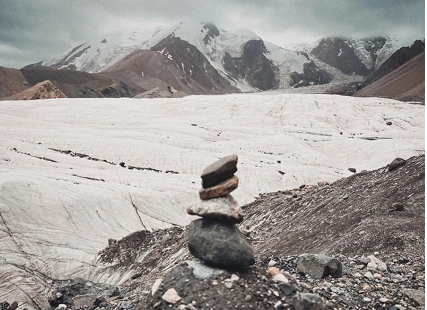The Mountains Know - Stones Speak
When the wind funnels through the passes, when snow settles on weary shoulders, those towers of rock stacked by pilgrims, wanderers, and solitary travelers become the earth’s most silent scriptures.
On the high passes of Tibet, they are called "mani piles” - each rugged slab carved with the six-syllable mantra, like bronze bells polished by the wind, murmuring beneath fluttering prayer flags. A believer’s palm
grazes the etched surface as if tracing the rings of reincarnation; to add a stone is to add the weight of a prayer, letting the divine glimpse human warmth through the fissures of rock.
Farther away, on desolate tundras and coastal cliffs, unnamed stone cairns stand just as solemn. Hunters in the Arctic use them to mark their return; shepherds in alpine valleys read them like compasses in the snow.

The meeting of stone upon stone is a traveler’s whisper to those who follow: "I passed this way—go safely." Sometimes, it is nothing more than a quiet ritual—resisting oblivion by stacking, letting chance encounters calcify into monuments under gravity’s pull.
We are always searching for a language more enduring than flesh. Mani piles are questions hurled into the void; cairns are answers etched in time. When these towers finally crumble, all devotion and solitude will return to dust—yet the mountains will remember how those unyielding shadows once stood, bone of stone, a silent sutra.
The Hidden Language of Stones: Between Science and Faith
Mani Stones


The Human Urge
Psychology whispers that stacking stones is an act of ordering chaos—a fleeting grasp at permanence in nature’s flux.
The Universal Code of Stacked Stones
From Himalayan trails to Scottish moors, from Inuit hunting grounds to Polynesian shores, humans have always piled rocks in silent consensus. This timeless ritual may spring from the same well in our souls:
- Memory in Mineral Before words, cairns were mankind’s first notebooks—Mongolian ovoo marking tribal boundaries, Andean apacheta guiding pilgrims. Each stone a knot in the thread of human wandering.
- Bridges to the Divine Celtic lore claims cairns house fairies; Tibetan wisdom sees unworked rock as alive. To shape stone is to reach for the sacred with bare hands.
- "I Was Here"
A modern hiker’s cairn and a Neolithic standing stone chant the same refrain: This is how we outlast time. A rebellion—ephemeral flesh borrowing geology’s eternity. - Archetypes in Rock
Jungians recognize cairns as the Wise Old Man incarnate—their triangular forms mirroring our psyche’s craving for stability, for waymarkers in the dark.
The towers will erode. But human longing still hums between the stones, warm as embers. When the last stacker vanishes beyond the horizon, these mute monuments will keep whispering:

See—this is humankind. Small as dust. Stubborn as bedrock.


